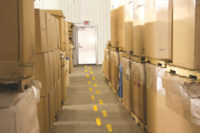When I think of the current situation regarding CFIA (Canadian Food Inspection Agency) regulations and Annex O outlining how harvesters and manufacturers are to control E. coli O157:H7, I’m reminded of a quote from the Charles Dickens book, A Tale of Two Cities: “it was the best of times, it was the worst of times.”
Although no one, especially me, could object about the advances that have been made by CFIA in its efforts to control E. coli O157:H7 at harvest, there still exists contradictions in the regulations that need a holistic approach by all of the players to reconcile.
A case in point:
Keeping with the latest food science wisdom, we are testing our incoming materials for indicative organisms, not so that we can declare our finished product “safe or safer.” We are testing raw material so we can determine if the upstream interventions by our suppliers (harvesters) are effective in destroying bacteria.
Recently we tested a lot of raw material provided to us by one of our key approved suppliers and to our surprise, instead of the usual less than 10 cfu’s /gram( a clear plate), we detected over 400 cfu’s per gram (multiple colonies).
As per our standard protocol we put the lot on hold having determined that our surveillance program did its job in detecting a lot where the harvester’s microbiological interventions clearly were ineffective in destroying microbiological contamination on the carcass. Moreover, the CFIA regulation specifies that a reading of generic E. coli over 100 cfu’s per gram is grounds for a full investigation.
Armed with these undeniable facts, we contacted our supplier, gave them the numbers, sent them pictures of the actual test plates so they could view the expansive colonies of generic E. coli that was detected in their raw material.
To our surprise they could not understand the rejection of their material, let alone our concern.
“A maximum for generic E. coli in CFIA regulations, never heard of such a thing!”
“Oh yeah, we know what your referring to now, however, that CFIA limit for generic E. coli is for manufacturers only. We can release raw material regardless of the levels of generic E. coli. It’s only when it’s converted into burgers that it becomes a concern by the CFIA. Sorry, can’t help you.”
I’m relieved and encouraged by the leaps the CFIA has made to ensure we are focusing our collective food science intelligence at source, where harmful bacteria originates, and are most easily inactivated. However, as can be seen by my story, we as an industry and our governments have more work to do to ensure any mandated regulations concerning acceptable levels of bacteria are enforced evenly across all players in the industry.
I recently read the note below in an industry e-mail blast regarding AMI (the harvest industry’s view). If this isn’t hypocritical I am not sure what is. This is the same industry group that supported E. coli 0157:H7 as an adulterant in ground meat while not holding its members accountable for prevention.
“AMI made its comments in response to Docket No. FSIS-2009-0034: Pre-Harvest Management Controls and Intervention Options for Reducing Escherichia coli O157:H7 Shedding in Cattle-May 2010 (Guide).” “AMI said pre-harvest programs would be difficult to implement because packers have no direct control over their supply base.”
“It was the best of times, it was the worst of times.”
John Vatri is the director of food safety for Mississauga, Ont.-based Cardinal Meat Specailists, one of Canada’s leading burger and cooked protein processors.
Related Articles
Related Products
See More ProductsSee More ProductsEvents
View AllSubmit An Event-
February 2, 2022 Class of 2021 Meat Industry Hall of Fame Inductee Roundtable
-
November 8, 2012 Food Plant of the Future: Hazardous Materials Storage and Use
×
Get our new eMagazine delivered to your inbox every month.
Stay in the know with The National Provisioner's comprehensive coverage of the meat and poultry processing industry.
SUBSCRIBE TODAY!Copyright ©2024. All Rights Reserved BNP Media.
Design, CMS, Hosting & Web Development :: ePublishing




Report Abusive Comment